As a result, cartoons play an important role in understanding American visual culture. Having been part of American print media since before the Revolutionary War (Benjamin Franklin’s famous “Join or Die” snake cartoon, created in 1754, is regarded as the first American editorial cartoon (Medhurst and Desousa 198)), American cartoons have been around longer than America has. America has subsequently produced a rich and influential visual culture and the realm of American politics has produced some of its most iconic symbols (e.g. “I want you” Uncle Sam, Obama “Hope” poster). As teachers of English and American culture, it is imperative that we convey to students the significance, meaning, and impact these images have on American society and, in many cases, the world. Learning how to read and interpret political cartoons fosters critical thinking skills and strengthens students’ abilities in reading and understanding text in general. This article will cover strategies necessary for interpreting cartoons and provide ideas for lesson plans centered on political cartoons.
How Can We Look at Cartoons?
Economist cartoonist Kevin Kallaugher has stated that political cartoonists wear three hats: that of an artist, a journalist, and a satirist (Kallaugher). This corresponds neatly with the taxonomy of text types1 one encounters in communication sciences: the expressive, the descriptive, and the operative (Schäffner 235-38). Although Medhurst and Desousa argue that political cartooning is ultimately a persuasive art form, the teacher will find all three of these domains important for the analysis of cartoons in the classroom. Arguably, the Aristotelian rhetorical concepts of pathos, ethos, and logos are factors that need to be accessed in terms of a cartoon’s success as well. Editorial cartooning is one of those rare types of text that combines all three of the aforementioned text types and therefore provides an exciting arena for us to see how these three domains interact and play off of each other to create meaning.
Medhurst and Desousa show how the analysis of political cartoons has taken the course of focusing on three distinct areas: psychoanalytic, sociological, and communicative. In recent years, political cartooning has drawn attention from the field of cognitive sciences, which is interested in the cognitive processes involved in interpreting and making sense of these images. The concept of the cognitive blend is an important one for the interpretation of political cartoons as disparate elements combine in the cartoon’s single-panel format to create the unified image. As Marín-Arrese states, “conceptual integration or blending, whereby two or more different mental spaces are brought together in a new mental space, is particularly relevant in cartoons” (5).
The Cartoonist’s Toolkit
Medhurst and Desousa highlight four major topoi the political cartoonist uses in his/her caricatures: political commonplaces (i.e. political topics such as the economy or foreign wars), literary cultural allusions, personal character traits, and situational themes (this would include controversial or noteworthy statements made by politicians, for example). Furthermore, a cartoon’s effect relies on the relevant cues, symbols, and references the cartoonist synthesizes into a whole. Here, we can draw upon one of the leading theories in communication sciences, Sperber and Wilson’s Relevance Theory, to support this phenomenon. For Sperber and Wilson, relevant communication “involves the least amount of effort for maximum cognitive gain” (Boase-Beier 277). Charles Forceville elaborates: “In order to achieve this, the sender of the message makes an assessment of what the addressee probably already knows, or can easily access by being (made) perceptually aware of his environment, in order not to overload the message itself with superfluous information” (250). Successful cartoonists have an intuition for relevance just as any other effective communicator does. Medhurst and Desousa focus on how this feature is crucial in the cartoonist being an effective persuader by “utilizing the beliefs, values, and attitudes of his audience” (204) as well as highlighting the importance of what the cartoon’s audience brings to its reading of caricature.
This intuitive ability to connect to the audience relates to Lakoff and Johnson’s revolutionary idea in the field of Conceptual Metaphor Theory: that using metaphor is part and parcel to communication, not a talent limited to poets and writers. In their seminal book Metaphors We Live By, Lakoff and Johnson illustrate how language informs us about the organization of our conceptual system, which they claim is “fundamentally metaphorical in nature” (3). As linguists, they focus on how metaphor is embedded in the language we use to express various concepts. The most famous and often cited of these conceptual metaphors is ARGUMENT IS WAR2, which can be seen in everyday statements like “Your claims are indefensible,” “His criticisms were right on target,” and “He shot down all of my arguments” (4). As we will see, metaphors also create the basis for how political cartoons are conceptualized.
The process of reading and interpreting a cartoon therefore involves the synthesis of many skills, as Medhurst and Desousa elaborate:
The cartoonist constructs his frame in such a manner as to compress into a single image the various streams of consciousness from which he has drawn his idea. Readers of political cartoons are not, therefore, processing a single, simple image when they place an interpretation on a caricature. Instead they are unpacking one of more layers of available cultural consciousness which the cartoon has evoked from them. (219)
Here, I would like to return to the topoi Medhurst and Desousa highlight in their work. Political commonplaces, personal character traits, literary cultural allusions, and situational themes are all topoi that are used to create satirical cartoons. These topoi can manifest in different elements and aspects of individual cartoons. (For example, personal character traits might appear in the exaggerated way in which a politician is drawn whereas situation themes might appear in a quote that frames the entire cartoon.) Not all political cartoons include literary cultural allusions, but the ones that do serve as particularly relevant artifacts for the American studies classroom. In the following section, I would like to focus on the following literary cultural allusions culled from my own work: folk knowledge and experience, world events and holidays, idioms and plays on words, metaphor and analogy, pop culture and allusion, and stereotypes.
Literary And Cultural Allusions in Election Cartoons
The domain of folk knowledge and experience can be one of the richest for analysis in the cross-cultural classroom as it is in this domain that we touch notions of mindset and collective experience. In a cartoon subtitled “The Anti-Capitalist System,” a husky young man in a black t-shirt emblazoned with the words “Occupy Wall Street” and wearing a propeller beanie (a symbol for childishness), sits at a lemonade stand on which simply “Gimme” (colloquial American speech for “give me”) is written. His pitcher has no lemonade in it; instead a small sign is taped to the pitcher on which “tips” is written. What’s more is that the cartoon’s lemonade stand is not located on a suburban sidewalk (as would be expected), but in a lemon orchard in which the boy and his stand are surrounded by dropped lemons. Although the cartoon is reliant on other (controversial) symbols to create a cohesive whole (i.e. the cartoonist’s use of the propeller beanie and the young man’s weight to index a lack of intelligence), the cartoon message hinges on using the lemonade stand as a stage. The American audience understands this to not only be an activity connected with childhood, but as a child’s first capitalist venture and with that a first step in the direction of adulthood or independence. The cartoon’s bite comes from the discussion surrounding Occupy as a movement consisting of young people without direction, many of whom might have obtained degrees and have moved back in with their parents. The lemons that lie at the feet of the young man at the lemonade stand represent the (economic) opportunities that abound; were it not for his incompetence and sense of entitlement—if he were to just pull himself up by the proverbial bootstraps—he would find success. The cartoon’s message therefore stands in direct opposition to what Occupy represents (and entirely neglects addressing the issue of fraud in the banking world that spurred the crisis) and taps into archaic ideas of achieving the American Dream. The “Anti-Capitalist System” in this cartoon then becomes a kind of anti-American system.
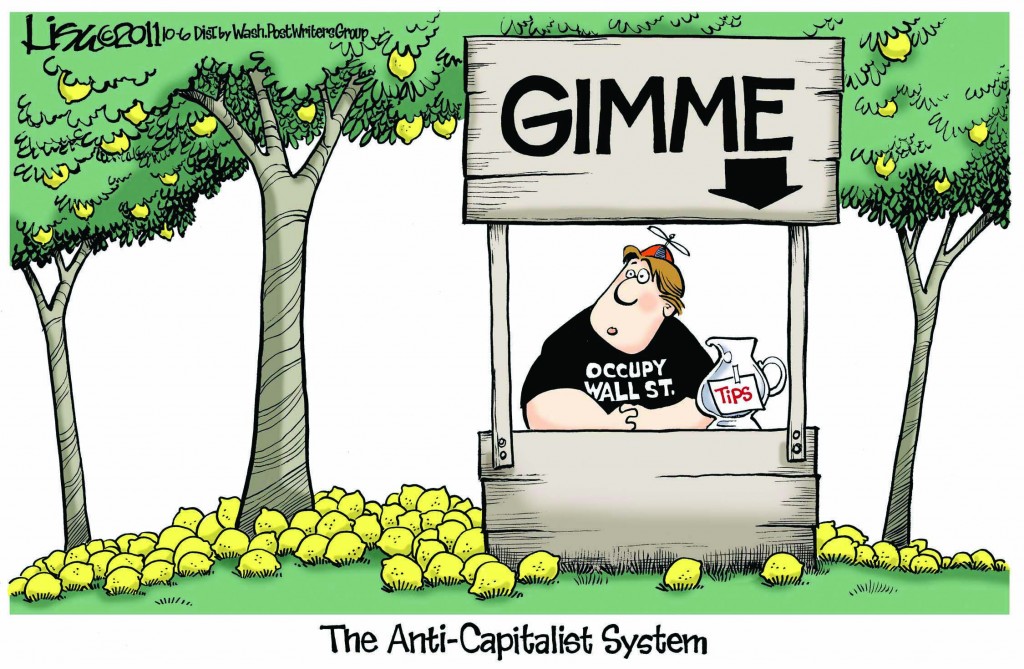
American political cartoonists on both sides of the political spectrum share the tendency to use world events and holidays as frames for their messages. Whereas the childhood lemonade stand was the frame in the previous cartoon and could be published at any time during the year, frames that make reference to recent world events or holidays have a restricted time period in which they can be published (and therefore often have a much faster expiration date). Examples of world events include the sinking of the Italian cruise ship Costa Concordia, which—although much more prevalent in European media—made its way into U.S. news at the beginning of 2012. One cartoon produced during this time featured a capsized cruise liner with the words “United States of America” on the front of the ship.
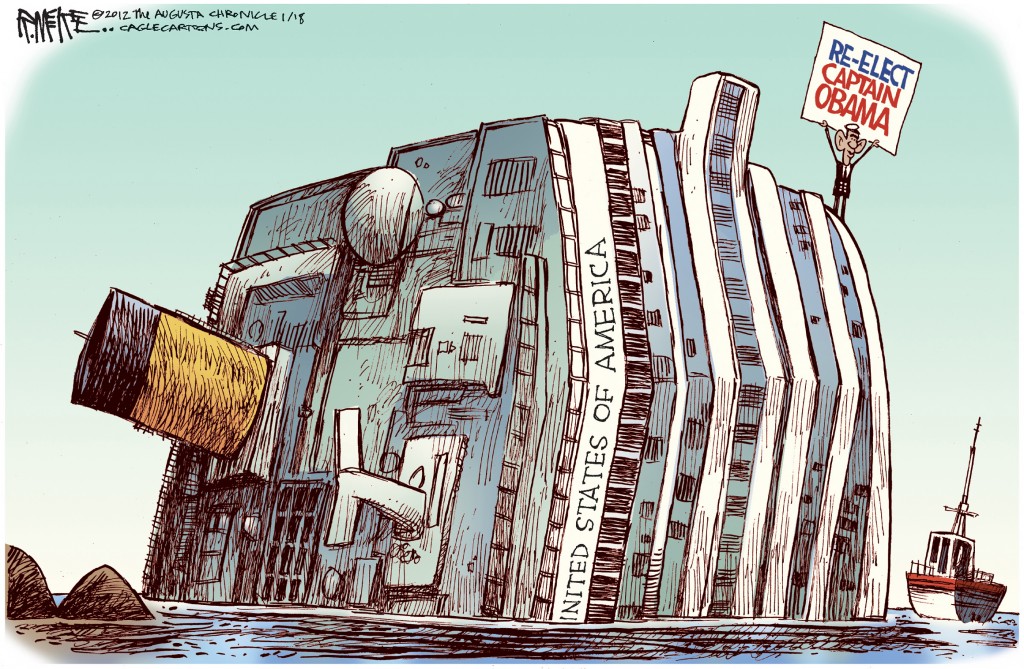
President Obama is seen standing on the non-submerged side holding a sign that says “Re-Elect Captain Obama.” The sinking ship metaphor is a common and universal one but what makes this cartoon particularly satirical is the fact that it was published within days of the accident and the fact that the accident was due to gross incompetence on the part of the captain. In 2012, the Summer Olympics in London served as a basis for plenty of cartoons surrounding the election. Considering the fact that POLITICS IS A RACE is one of the most common political metaphors (e.g. “frontrunner,” the “home stretch,” “to be neck and neck”), the timing could not have been more suitable.
Holidays and perennial American events (e.g. the Oscars) also serve as stages for cartoons. During the week of Valentine’s Day, a cartoon was published that featured a mother and her daughter sitting together on a sofa. The daughter, head over heels in love, is gleefully clutching a huge heart-shaped candy box with the word “Obama” written on its big yellow bow. The box is open and there are in fact no chocolates inside. The mother—turning from reading her newspaper—says to her daughter, “It’s an empty box,” and her daughter replies, “But it makes me feel so hopeful.” The artist who produced this cartoon, Lisa Benson, also produced the lemonade stand cartoon featured above, so it is noteworthy that she uses the frames of folk experience and holidays to set the stages of both of these cartoons as well as employs indexical symbols to support her commentary. (In this Valentine’s Day cartoon, she reduces a generation of Obama supporters to a young woman blinded by infatuation and counterbalances this image with the sober, presumably more conservative mother whose wisdom is represented in her newspaper reading).
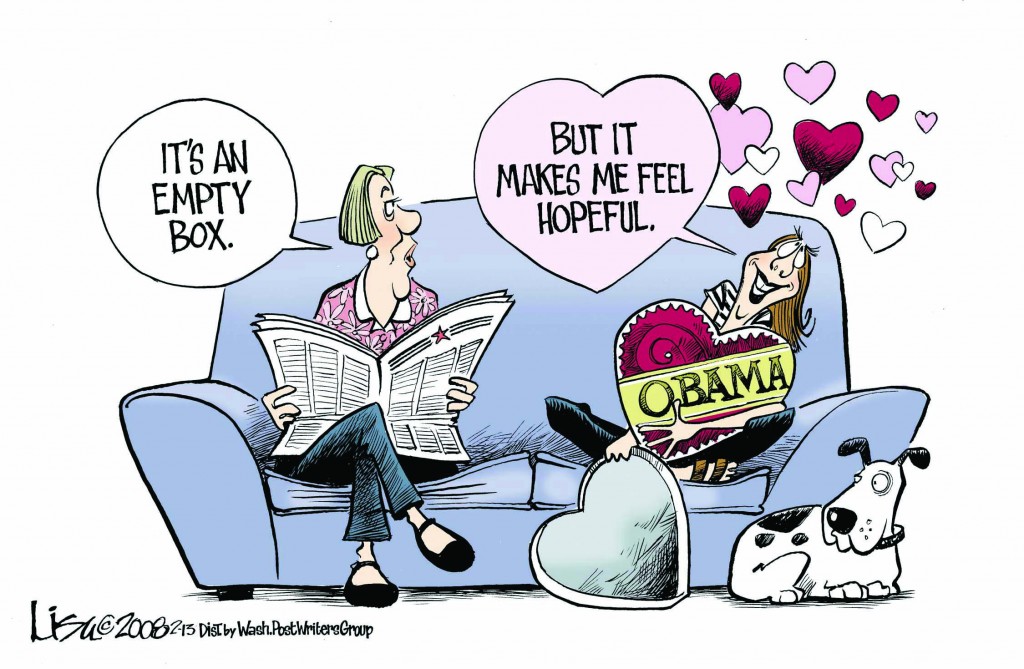
Idioms are also employed by political cartoonists as a kind of visual shorthand for the persuasive points they wish to make. In a cartoon that criticized Mitt Romney for his gaffs concerning the London Olympics (he had claimed that London did not appear to be well prepared), Romney is seen holding a bow and arrow in front of a blank bull’s eye labeled “Overseas Trip” with most of his arrows sticking out of his feet.
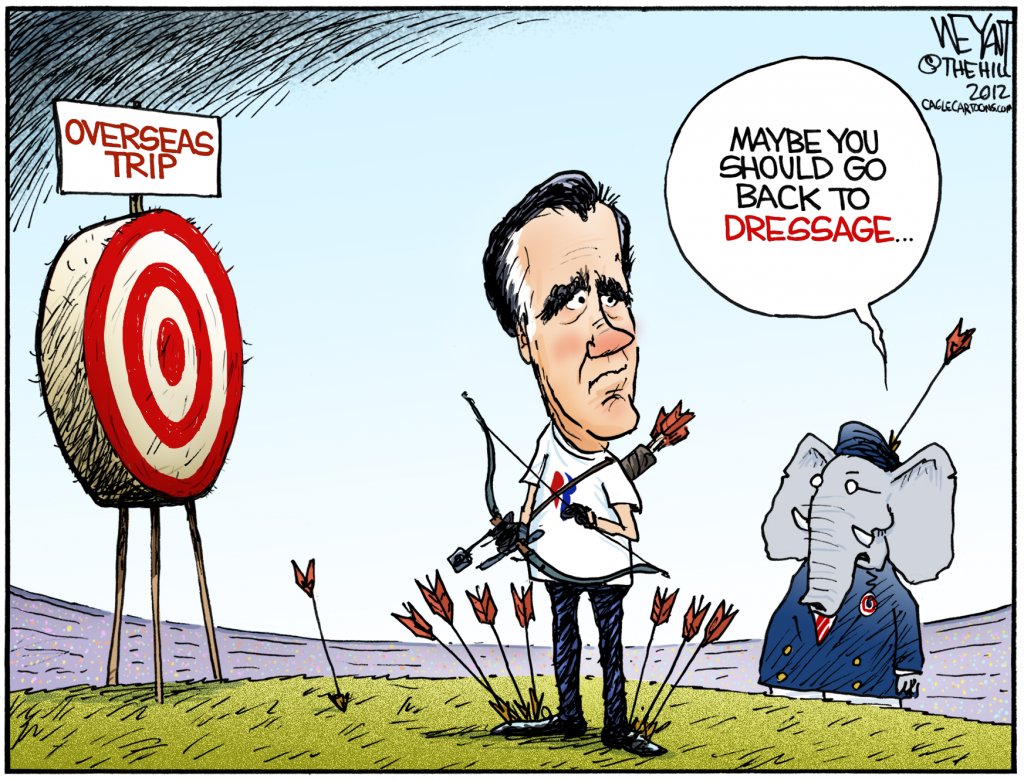
The idioms “to miss the mark” and “to shoot oneself in the foot” are referenced here and support the cartoon’s text coming from an elephant dressed as an Olympic judge in the background: “Maybe you should go back to dressage.” The reference to dressage underlines the trend in critical cartoons of 2012 depicting Republican presidential candidate Mitt Romney as being elitist and unapproachable.
Considering the significant role American popular culture plays in American language and humor, it should come as no surprise that cartoons weave references to pop culture into their message as well. In a cartoon produced during the period of Obama’s stimulus packages for the American economy, we see a hopeful-looking Obama in a pumpkin patch holding a sign that says, “Welcome Great Recovery.”
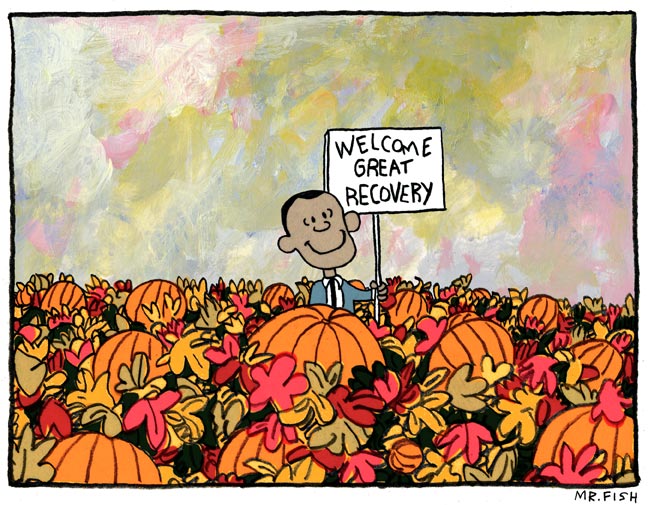
The cartoon alludes to Charles Schulz’s famous Peanuts characters and is a direct reference to the 1966 animated cartoon It’s the Great Pumpkin, Charlie Brown in which the naïve character of Linus awaits the Great Pumpkin on the night of Halloween. The Great Pumpkin invariably never shows up but it does not keep the optimistic Linus from trying year after year. In this example, a shot from the animated film serves as the metaphorical frame for the cartoon. The analogies made between Linus and Obama and the Great Pumpkin and the Great Recovery are facilitated by knowledge of the pop culture reference. This technique is identical to that of the frames used with metaphor, idiom, and scripted folk experience, which provide rigid roles for the actor(s) in the cartoon. The cartoon’s potency derives from appropriate role assignment, allowing even a reader of a different political persuasion to appreciate the proposed analogy.
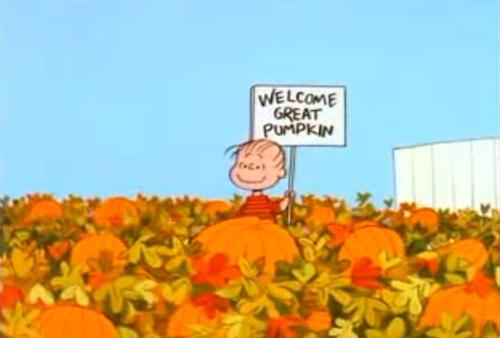
In analyzing all literary cultural allusions, one must be aware that the line between prototype and stereotype is a blurry one, and that political cartoons often cross this line. As Marín-Arrese states, “cartoons very often exploit traditional stereotypes to reinforce the process of prejudice formation (cf. Hünig), thus reshaping the readers’ mental representations of events as well as their social, cultural, and world knowledge” (10). Students are encouraged to look at images critically and observe trends in the representation of groups of people and themes in the work of individual cartoonists as well as in groups of cartoons that address certain political commonplaces. An exercise for students could involve defining what constitutes a taboo image for one society that might be completely acceptable in another. What associations do these images have and what cultural frames of reference do they represent? Students should also be encouraged to reflect on what constitutes a political cartoon (and political satire in general). When does an image qualify as satirical and when does it not? How can we know the intent of the artist creating these images?
We now turn to four specific lesson plans that can be used in the foreign American studies classroom.
Lesson 1:
Comparing Cartoons in a Cross-Cultural Context
One way of using cartoons in lessons is to compare them across cultures. Janis L. Edwards states: “As rhetorical texts, political cartoons assist not only in interpreting and framing political discourse but offer symbolic constructions of political and national identities” (Edwards and McDonald 317). Furthermore, Edwards and Ware state that political cartoons are “imagined worlds inhabited by…characters in the political scene” (468). These imagined worlds are arguably restricted by their respective cultures and therefore yield interesting results, particularly in cases in which the topic is not a domestic one (often then only resulting in cartoons from the country of origin), but an international one yielding a variety of images and interpretations.
In a course entitled Reading American Politics: An Intercultural Perspective taught at the University of Greifswald in Germany, we explored how international topics like the global financial crisis3 were depicted in political cartoons. In 2012, the EU bailout of Greece became a focus in the news that was echoed in political cartoons. In both German and American cartoons common symbols were employed: columns, gods, myths. However, both cultures produced Germany-specific and US-specific images. In one American cartoon, the sunrise “O” logo associated with the Obama campaign features a sign on its red-and-white striped field on which is written “Welcome to Greece.” (German cartoons do not make reference to American campaign logos as these symbols would not be widely known in the German audience.)
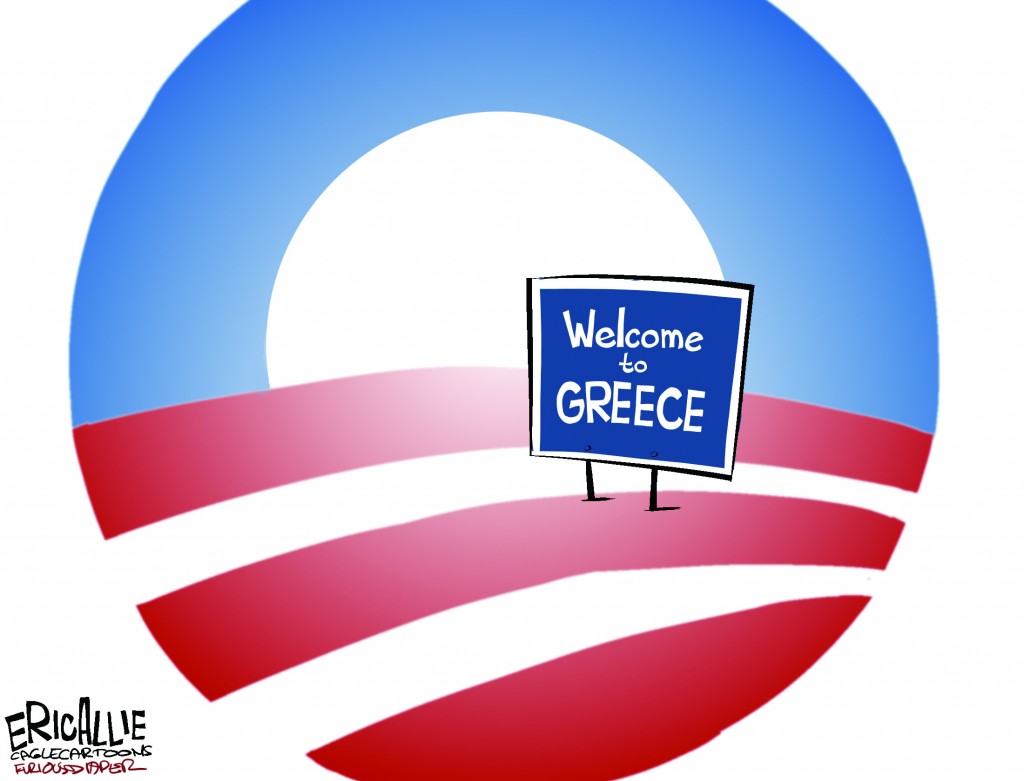
Another American cartoon featured the Greek god Icarus with the word “Greece” written on the god’s loincloth. In the cartoon, the wings that are starting to melt are not made of wax, but of a VISA and MasterCard.
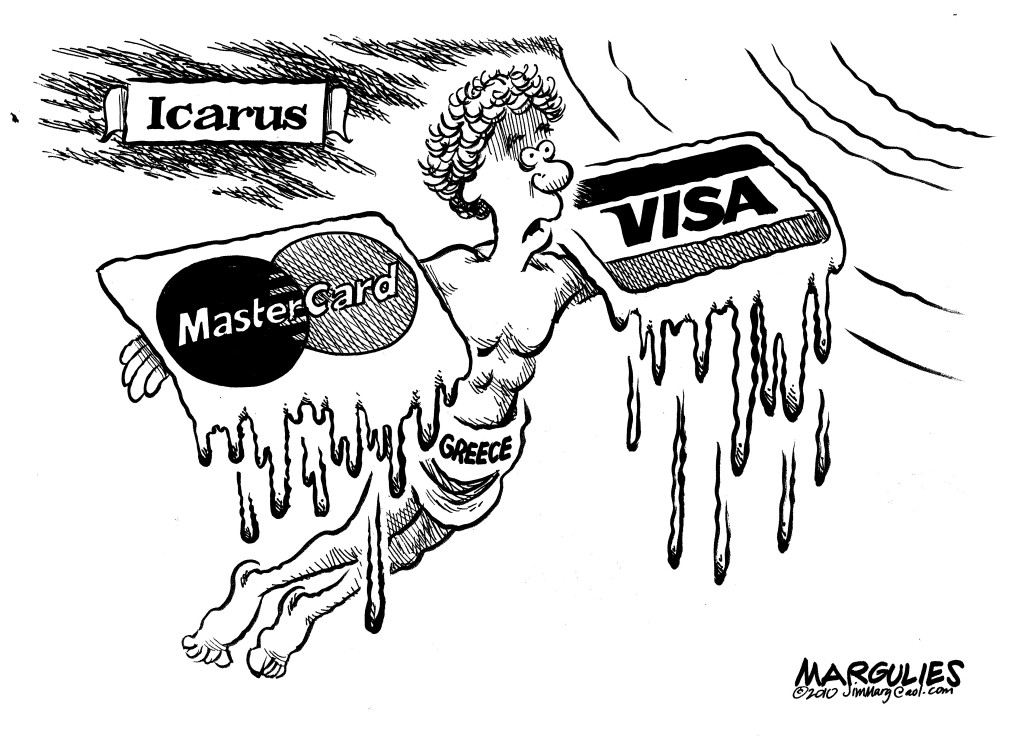
This is an interesting representation of the American conceptualization of debt—that private debt would be akin (possibly be even the source) of public debt. In the German mindset, private debt and public debt are not comparable and therefore do not manifest in such images4. (Additionally, credit card debt does not play nearly as large a role as it does in the average American’s life and therefore lacks any potency as a symbol.) The image also evokes the idiom of “flying too close to the sun,” a standard idiom in English describing foolhardy risk.
By contrast, German cartoons often include visualizations of the terms and expressions used in the media in association with the European debt crisis. In one cartoon, a man holding a Greek flag is standing on the edge of a cliff marked with the sign “Sie verlassen jetzt die Euro-Zone” (“You are now leaving the Eurozone,” an allusion to the famous sign at Checkpoint Charlie in former West Berlin). A faceless body of people covered by an umbrella featuring the blue and yellow-star motif of the flag of the European Union holds a knife to the man’s back and says, “Nur Mut! Das verschafft Dir völlig neue Möglichkeiten!” (“Have heart! This will create new opportunities for you!”). Although the falling cliff metaphor and the image of the umbrella evoking a sense of protection are arguably universal, a non-German-speaking reader would probably miss the fact that the concept of the Rettungsschirm (euro rescue package, lit. “rescue umbrella”) is referenced. Other linguistic references in German cartoons have included the visualization of the PIIGS abbreviation (representing countries at risk: Portugal, Ireland, Italy, Greece, and Spain) in the form of pig images as well as the Schuldenbremse (debt limit, lit. “debt brake”).
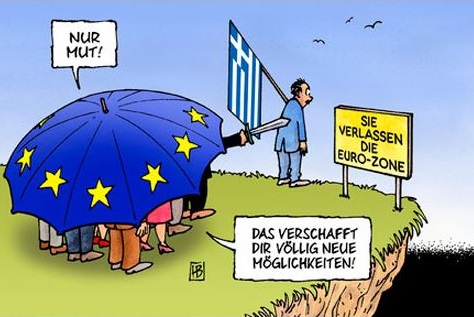
Teachers can choose political commonplaces covered in both American political cartoons and those cartoons produced in their native cultures. (Of course, assigning students the task of assessing what the topics are not mutually covered by American cartoons and the cartoons of their home country yields important insight as well.) Using the topoi featured above, students should be encouraged to discover how artists between the two cultures use literary cultural allusions, personal character traits, and situational themes in similar and different ways. Teachers should facilitate students in identifying and interpreting (recurring) symbols. (See the links included at the end of this article for sources for American political cartoons.)
Lesson 2:
Identifying Idioms and Metaphors in Political Cartoons
Without making reference to Lakoff and Johnson’s Conceptual Metaphor Theory (CMT), Medhurst and Desousa highlight some important metaphors that provide the stage for many cartoons in their analysis. These metaphors include: politics is a battle, a race, a gamble, a media event, a circus, and a beauty contest (222). Additionally, Marín-Arrese illustrates the conceptual metaphor A NATION IS A PERSON (featuring a cartoon in which Britain is represented by a fox hunter and France is represented by La Marianne5). CMT has made a great impact on fields related to linguistics and communication studies, and provides an interesting theoretical framework for the analysis of various kinds of texts (e.g. political speeches, news reports, campaign ads) in the classroom. In my own classes, I have had success with asking students to identify conceptual metaphors in individual cartoons and cartoons I have grouped together that share one common conceptual metaphor. One can make this a cross-cultural activity by having students identify the common and different conceptual metaphors used to describe politics in American cartoons and those of their home culture. Similarly, I have used political cartoons in my idioms course for advanced learners of English in order to test critical thinking skills and facilitate the learning of new idioms. Political cartoons offer the EFL teacher a clear-cut way of testing both linguistic and cultural competence.
Lesson 3:
Campaign Posters
In an election year, images of campaign posters provide a perfect source for political analysis. In my own courses, I placed posters from Romney and Obama and the two major German political parties (the Christian Democrats and the Social Democrats) side by side and asked my German students to compare and contrast these images. (In semesters in which I had Erasmus and other foreign exchange students, I incorporated posters from their home countries as well.) Campaign posters have an interesting way of summarizing much of the election process and highlighting cultural peculiarities. In 2012 both Romney and Obama’s posters featured a logo made from their names, which is characteristic of modern American elections. The colors of the American flag are incorporated in this logo and—most fascinating for the outsider looking in—no references to the candidate’s party are made on the poster. The poster is purely indexical and campaigns therefore rely on other modes of advertising to introduce the candidate’s platform to the audience. In contrast, German campaign posters often fit a set format (although smaller parties like the Greens and the Pirates often deviate from this formula): a headshot of the candidate takes up the majority of the poster’s space and is accompanied by the candidate’s name and the logo of the candidate’s party (all German parties have official logos). Slogans may or may not accompany these posters.
The American campaign posters confirm the idea that American society is oriented towards the individual (e.g. the lack of any reference to the candidate’s party) and demonstrate the classic American career advice that one must “brand” oneself. The candidate him or herself becomes the logo in place of the party, echoing many a swing or independent voter’s conviction in voting for “the candidate and not the party.” In contrast, voting for the party with less focus on candidates is more relevant for a parliamentary democracy like Germany. This has huge implications for the election process in general (and explains the singularity of the American election process) and these differences manifest themselves in campaign images. The use of photos on German campaign posters is perhaps the most striking difference and reflects the working world in which most Germans include a photo in their applications for jobs (which is by contrast illegal in the United States).
Lesson 4:
Cartoon Case Study
A good deal of academic work on political cartoons has involved researchers compiling cartoon corpora that cover specific topics or feature a certain politician. Noteworthy examples have included analyses of the cartoons created during Hurricane Katrina (Kelley-Romano and Westgate), the depiction of West and East during German Reunification (Morrison), the representation of radical Islam in cartoons (Jackson), the 2004 presidential race between George W. Bush and John Kerry (Conners), and representations of Hillary Clinton and Sarah Palin during the 2008 election (Edwards and McDonald). These articles can serve as inspiration for students compiling their own corpora. My own comparison of Barack Obama and Mitt Romney in cartoons yielded trends in cartoons capturing the disappointment in both of these candidates from their respective parties: Obama as the disappointing “dream man” and Romney as an undesired groom (from which the conceptual metaphor POLITICS IS COURTSHIP emerges). Other similarities included general depictions of Obama being weak or “wimpy” and Romney being a weak candidate in terms of his consistent flip-flopping on issues (represented in some cartoons literally by having the caricature of Romney wear flip-flops). Being elitist and unapproachable were characteristics attributed to both candidates. Similar to the method used in Lesson Plan #1, students and teachers alike can create their own cartoon corpora for analysis of how a particular political commonplace or a set of politicians (and their personal character traits) are represented.
The Future of Cartoons
With the folding of many major newspapers in the United States and around the globe, there has been much discussion surrounding the future of political cartoons. Many newspapers have had to fire their editorial cartoonists; today, the current number of editorial cartoonists on staff at U.S. newspapers is under 50; at the start of the twentieth century, there were around 2,000 (Herb Block Foundation Report). As veteran cartoonist Pat Oliphant writes:
that once potent galvanizer of opinion, the kick-starter of conversation and discussion, has been allowed to atrophy from disuse, and is, after several centuries of successful use as a castigator and common scold of the body politic, in great jeopardy of fading away altogether. (Oliphant 25)
In the words of researcher Susan S. Morrison: “Political cartoons teach us how to read” (50). There are arguably few art forms that are as valuable to the educator in terms of facilitating critical thinking, interpretation, and analysis in such an entertaining way as political cartoons. Political cartoonists are in equal parts artist, journalist, and satirist. They use topoi and metaphor to structure the cartoons and condense meaning into the one-panel format. Additionally, we have explored how to use cartoons in lessons centered on areas relevant to the foreign American studies classroom including cross-cultural analysis, metaphor, and idioms. Teachers and educational researchers alike are encouraged to contribute to the growing body of research in this field to facilitate innovative lessons.
Finding Cartoons
The Web is probably the best source for culling cartoons. The databank Cagle Cartoons conveniently sorts cartoons by thematic category and is frequently cited in academic work on political cartoons. Using a search engine like Google’s Images Search can be very useful to find cartoons related to various news events, politicians, or even idiomatic expressions. Other useful links are included below:
Cagle Cartoons: http://www.cagle.com
Yahoo! Comics (editorial cartoons featured at the bottom of the page): http://news.yahoo.com/comics
The Association of American Editorial Cartoonists: http://editorialcartoonists.com
Cartoons for the Classroom (lesson plan newsletters from the AAEC): http://nieonline.com/aaec/cftc.cfm
GoComics.com editorial cartoon pages: http://www.gocomics.com/explore/editorials
About.com Political Humor: http://politicalhumor.about.com/library/bl-political-cartoons.htm
Notes
3 This was a topic particularly relevant for the study of political cartoons as publicity surrounding the use of Nazi symbols in the depiction of Germany and Angela Merkel in Greek political cartoons was making its way into the German press at this point.
4 Although interestingly there has been a link between private and public spending habits in the German press with Merkel being compared to the schwäbische Hausfrau (lit. “Swabian housewife”), making reference to the region of Germany, Swabia, stereotypically known for its thrift.
5 This appears to be a cross-cultural trend, with the famous example of Uncle Sam representing the United States. German cartoons also often utilize what is known as der deutsche Michel (“the German Michel”) to represent the nation at large. A notable difference between Uncle Sam and the German Michel, however, is the fact that Uncle Sam is used to represent the American nation in foreign press whereas the German Michel is only used by German cartoonists for German readers. In international contexts, both Germany and the US are often represented by their respective national eagles.
Works Cited
Edwards, Janis. L. “Visualizing Presidential Imperatives: Masculinity as an Interpretive Frame in Editorial Cartoons, 1988-2008.” Gender and Political Communication in America: Rhetoric, Representation, and Display. Ed. Janis. L. Edwards. Lanham: Lexington, 2009. 233-50. Print.
Edwards, Janis L., and C. Austin McDonald II. “Reading Hillary and Sarah: Contradictions of Feminism and Representation in 2008 Campaign Political Cartoons.” American Behavioral Scientist 54.3 (2010): 313-29. Print.
Edwards, Janis L., and Laura Ware. “Representing the Public in Campaign Media: A Political Cartoon Perspective.” American Behavioral Scientist 49.3 (2005): 466-78. Print.
Forceville, Charles. “Addressing an Audience: Time, Place, and Genre in Peter van Straaten’s Calendar Cartoons.” Humor 18.3 (2005): 247–78. Print.
Herb Block Foundation. The Golden Age for Editorial Cartoonists at the Nation’s Newspapers is Over. Herb Block Foundation, 2011. Web. 2 June 2014. <http://www.herbblockfoundation.org/sites/default/files/imce_uploads/pdfs/hbf2011whitepaper_f1.pdf>.
Jackson, Liz. “Images of Islam in US Media and their Educational Implications.” Educational Studies 46.1 (2010): 3-24. Print.
Kallaugher, Kevin. Skype interview. January 2012.
Kelley-Romano, Stephanie, and Victoria Westgate. “Drawing Disaster: The Crisis Cartoons of Hurricane Katrina.” Texas Speech Communication Journal 31.1 (2007): 1-15. Print.
Lakoff, George, and Mark Johnson. Metaphors We Live By. London: U of Chicago P, 1980. Print.
Long, Mark, Rick Bunch, and Robert E. Lloyd. “Anti-Americanism, Political Cartoons, a Socio-Geographic Imagination: An Invitation to Further Work.” Sociological Inquiry 80.4 (2010): 650-60. Print.
Marín-Arrese, Juana I. “Cognition and Culture in Political Cartoons.” Intercultural Pragmatics 5.1 (2008): 1-18. Print.
Medhurst, Martin J., and Michael A. Desousa. “Political Cartoons as Rhetorical Form: A Taxonomy of Graphic Discourse.” Communication Monographs 48.3 (1981): 197-236. Print.
Morrison, Susan S. “The Feminization of the German Democratic Republic in Political Cartoons 1989-90.” The Journal of Popular Culture 25.4 (1992): 35-52. Print.
Oliphant, Patrick. “Why Political Cartoons are Losing Their Influence.” Nieman Reports (2004): 25-27. Print.
Schäffner, Christina. “Skopos Theory.” Routledge Encyclopedia of Translation Studies. Ed. Mona Baker. London: Routledge, 2001. 235-38. Print.
Author
Suggested Citation

This work is licensed under a Creative Commons Attribution-ShareAlike 3.0 Unported License.


